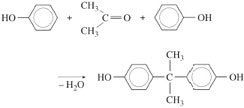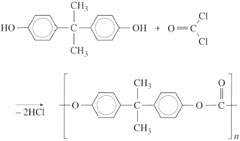3.3.3 Higher aromatics
Benzene rings can be fused in various ways to create component parts for some of the complex aromatic repeat units shown in Table 5. One of the most important is bisphenol A, made by fusing two phenol rings with acetone:

This intermediate is important for a number of speciality polymers, for example, polycarbonate and epoxy resins. Epoxies were developed in the early 1940s, and they found eventual use in aircraft construction for high-strength adhesive bonding. They continue in popularity as speciality adhesives and are also important in polymer composite materials, where they are used as the matrix for glass and carbon fibres. Condensation of bisphenol A and epichlorhydrin yields prepolymers of the kind:

Since MR is very large (284), n = 1 to ca. 10 in the prepolymers of molecular masses up to 3000. Not only are there reactive epoxy groups at the chain ends but also hydroxyl groups in the repeat units which are available for crosslinking by multi-functional amines.
With bisphenol A available commercially as a relatively cheap intermediate, its potential for use in thermoplastic materials was exploited in the development of polycarbonate resins by simply reacting the material with phosgene gas, COC12:

More recent exploitation of this linked phenol has occurred in certain grades of polysulphones and polyimides.
